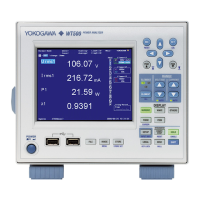9-16
IM 760201-01E
Explanation
Converting to CSV Format
After storage has finished, you can select stored numeric data files and convert them to
CSV files.
•
When you convert data that is stored on the internal RAM disk (“[RAM0-0]”), the CSV
file is created in the root directory of the USB memory device whose ID number is 0.
•
When you convert data that is stored to USB memory (“[USB 0-0]” or “[USB1-0]”), the
CSV file is created in the same directory as the numeric data files that it is converted
from.
Note
CSV files are created from a pair of files that consists of a stored numeric data file (.wts) and a
header file (.hds) with the same name. Do not change the names of stored numeric data (.wts)
and header (.hds) files for different sets of data to the same name. If you do so, the WT500
may malfunction and the storage medium may be damaged.
9.7 Converting a Stored Binary Format File to CSV Format

